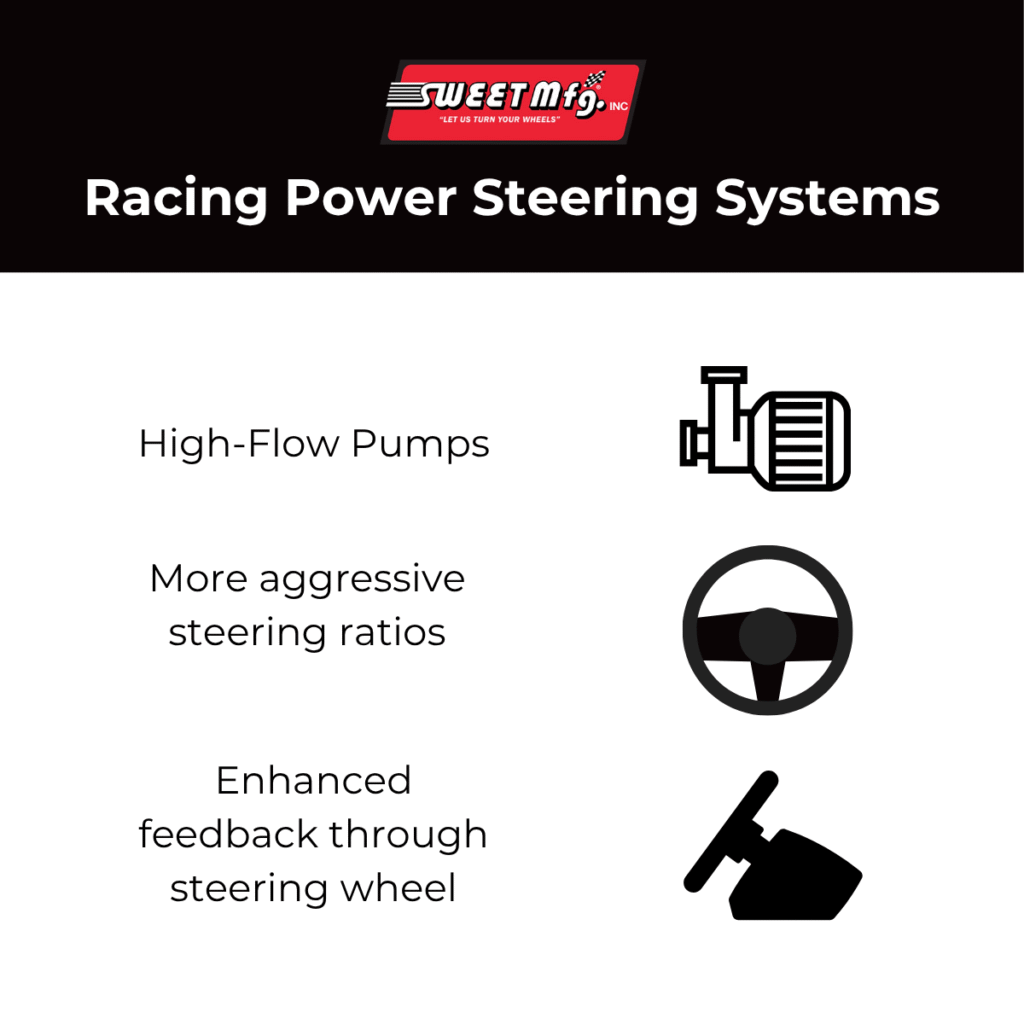Table of Contents
The Short Answer: Power steering fluid should be changed every 30,000-50,000 miles for regular vehicles, though this can vary based on vehicle age, driving conditions, and manufacturer recommendations. Racing vehicles require much more frequent maintenance, with fluid changes needed every 2000-5000 laps to maintain optimal steering response under extreme conditions.
Power steering fluid transfers power from your vehicle’s steering wheel to the steering mechanism, reducing the force needed to turn the wheels to allow you to effortlessly maneuver your car. If a vehicle’s power steering fluid is not properly maintained, the vehicle becomes different to steer, potentially creating dangerous driving conditions. By understanding the appropriate maintenance guidelines and recognizing warning signs of deteriorating fluid, you can prevent costly repairs and maintain optimal steering performance.
Understanding Power Steering Systems
Most vehicles use a hydraulic power steering system, with the power steering pump providing a flow of fluid to the steering gear, creating enough pressure to overcome the resistance from the wheels with minimal input effort.
The power steering pump maintains a constant flow of fluid in the system, with the fluid acting as both a hydraulic medium and a lubricant for the system’s moving parts.
Types of Power Steering Systems
Modern vehicles utilize several different power steering designs:
Hydraulic Power Steering (HPS): The traditional system used for decades, it relies entirely on hydraulic pressure generated by a pump driven directly by the engine. These systems are durable but less efficient since the pump is driven directly off the engine
Electric Hydraulic Power Steering (EHPS): This hybrid system uses an electric motor to power the hydraulic pump instead of the engine. This design improves fuel efficiency while maintaining the familiar hydraulic operation.
Electric Power Steering (EPS): An increasingly common system in newer vehicles, EPS eliminates hydraulic fluid entirely. Instead, an electric motor provides steering assistance based on input from sensors. These systems don’t require fluid changes but have their own maintenance considerations.
Types of Power Steering Fluid
Power steering systems require specific fluid types to function correctly:
Automatic Transmission Fluid (ATF): Many older vehicles use transmission fluid (often Dexron/Mercon types) in their power steering systems. This reddish fluid has good lubricating properties but isn’t specifically formulated for steering systems. ATF is sometimes used in production vehicles and is not recommended for racing.
Dedicated Power Steering Fluid: Specifically designed for power steering systems, this fluid contains additives that protect seals, prevent foaming, and resist breakdown under high temperatures and pressures.
Synthetic Power Steering Fluid: Offering superior performance in extreme conditions, synthetic fluids generally last longer and maintain their properties better than conventional fluids, potentially extending change intervals.
Power Steering Fluid Maintenance
Manufacturer recommendations for power steering fluid changes vary significantly between vehicle makes and models. Some automakers specify regular intervals, typically between 30,000 to 60,000 miles. For racing, this is often measured in laps or nights of racing.
Creating a Maintenance Schedule
For vehicles with specific manufacturer fluid change intervals, follow these guidelines as a minimum requirement. For vehicles without clear specifications, consider these general rules:
- Change power steering fluid every 50,000 miles or 4-5 years for normal driving conditions
- Inspect fluid condition every oil change (check color and level)
- Perform a complete system flush when changing fluid, not just a drain and fill
- Consider more frequent changes (30,000 miles) for older vehicles or those driven in severe conditions (offroad or racing)
Document each fluid change in your maintenance records, noting the type of fluid used and current mileage for future reference.

Factors That Might Affect Power Steering Maintenance Needs
Several conditions can accelerate power steering fluid degradation, requiring more frequent maintenance:
Driving Conditions
Certain driving patterns place additional stress on your power steering system:
- Frequent short trips prevent the fluid from reaching optimal operating temperature
- Extreme climate conditions (both hot and cold) can accelerate fluid breakdown
- Off-road driving introduces more contaminants into the system
- Towing or hauling heavy loads increases pressure and heat in the system
- Stop-and-go city driving requires more frequent steering inputs than highway driving
- High performance or racing conditions
Vehicles regularly exposed to these conditions should have their power steering fluid changed 25-50% more frequently than manufacturer recommendations.
Vehicle Age and Mileage
As vehicles age, seals naturally deteriorate and may introduce small metal particles and rubber seal material into the fluid. High-mileage vehicles (over 100,000 miles) benefit from more frequent fluid changes—typically every 30,000 miles or two years—even if the manufacturer suggests longer intervals.
Vehicles 15 years and older with original steering components are particularly vulnerable to contaminated fluid and should receive more attentive maintenance to prevent system failure.
Previous Damage or Maintenance History
Vehicles with previous steering system repairs present special considerations:
- Recent rack and pinion or power steering pump replacement
- History of power steering leaks or repairs
- Previous fluid contamination incidents
- Steering component rebuilds rather than new replacements
After major steering system repairs, change the fluid again after 5,000-10,000 miles to remove any debris that might have been introduced during repair work. Improper power steering fluid maintenance can have short-term and long-term effects on the vehicle and the driving experience, so it’s important to pay attention to potential concerns and quickly resolve them.

Signs Your Power Steering Fluid Needs to Be Changed
Regular visual inspection and steering performance can reveal early signs of fluid degradation:
Fluid Color Changes: Fresh power steering fluid is typically clear or amber. As it degrades, it darkens to brown or black, indicating oxidation and contamination.
Visible Contamination: Metal flakes or foam in the fluid suggest system damage or air intrusion. These contaminants accelerate wear on precision components like valves and seals.
Low Fluid Level: Consistently decreasing fluid levels indicate leaks that need immediate attention. Even small leaks can eventually introduce air into the system, causing potential damage.
Steering Wheel Resistance: If turning the steering wheel becomes noticeably harder, the fluid may be degraded or the system may be low on fluid.
Unusual Noises: A whining or groaning noise while turning the wheel, often indicates air in the system, low fluid levels, or pump wear accelerated by contaminated fluid.
Inconsistent Steering Response: Steering that feels normal sometimes but stiff or sluggish at other times suggests fluid issues or air in the system.
Steering Wheel Vibration: Vibration or shuddering when turning can indicate fluid aeration or pump problems caused by poor maintenance.
Check your fluid by examining the reservoir. The fluid level should be 2+ inches over the return inlet. It is important that this is submerged in fluid at all times. Fluid levels should never be lower than the return.
Racing Vehicle Considerations for Power Steering
In the high-stakes world of competitive racing, power steering is a critical performance component that requires meticulous attention to power steering maintenance to maintain peak performance and reliability. Racing puts extraordinary demands on steering systems, with rapid directional changes and sustained high-speed operation generating intense heat and pressure within the power steering system.
Unlike traditional passenger vehicles, racing power steering setups utilize specialized components built specifically for high-performance applications. Internal valving is optimized for quicker response times. Racing power steering systems are precision-engineered to operate under significantly higher pressures (typically between 1,500-2,000 PSI compared to 800-1,000 PSI in standard vehicles) to deliver the rapid response and precision that professional drivers require under extreme conditions.

Differences in Racing Power Steering
The most notable differences between racing and standard automotive power steering systems are in their construction and operation parameters.
High-Flow Pumps: In racing systems, these are matched with performance-grade hoses rated for elevated pressures.
Steering Ratio: To allow for directional changes with minimal input racing steering ratios are typically more aggressive.
Higher Temperature Capacity: The entire system is designed to maintain control at racing speeds by operating reliably at sustained temperatures while providing enhanced feedback through the steering wheels.
Perhaps most importantly, racing power steering systems utilize specialized valving that modulates assistance based on steering input, providing enhanced feedback through the steering wheel. This ensures that drivers maintain optimal feel and control throughout various racing conditions. This engineering requires pristine fluid conditions to maintain peak performance, making routine maintenance critical in racing applications.
Trust Sweet Manufacturing for Your Racing Power Steering Needs
Maintaining optimal power steering fluid levels and quality is crucial for peak racing performance and vehicle control. Professional race teams change power steering fluid every 500 – 1000 laps. Amateur racers should perform changes at least 1-2 times per season or when replacing steering components to ensure consistent steering response and component protection.
Regular maintenance delivers multiple performance advantages: precise steering feedback, reduced component wear, better heat management during intense racing conditions, and prevention of costly system failures. For maximum reliability, always use racing-specific power steering fluid rated for high-temperature operations and pair it with premium racing components designed to handle extreme stress.
Ready to upgrade your race car’s steering performance? Sweet Manufacturing’s specialized racing power steering pumps, reservoirs, rack and pinions, and more are engineered specifically for competitive motorsports applications. Reach out to us today to discuss the steering solution that meets your racing program’s needs.


